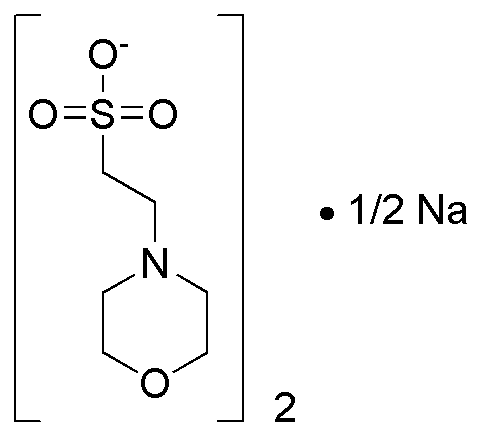2-(N-Morpholino)ethanesulfonic acid hemisodium salt is widely utilized in research focused on:
- Biological Buffers: This compound serves as an effective buffering agent in biological and biochemical research, helping to maintain stable pH levels in various experiments, which is crucial for enzyme activity and cell culture.
- Pharmaceutical Formulations: It is used in the formulation of pharmaceutical products, enhancing the solubility and stability of active ingredients, thereby improving drug delivery and efficacy.
- Electrophoresis: Commonly employed in electrophoresis techniques, it aids in the separation of biomolecules, providing clearer results in DNA, RNA, and protein analysis.
- Cell Culture Media: This chemical is incorporated into cell culture media, supporting optimal growth conditions for various cell types, which is essential for research in cancer, immunology, and regenerative medicine.
- Analytical Chemistry: It is utilized in analytical methods, such as chromatography, where it helps to stabilize pH during the separation of complex mixtures, leading to more accurate and reproducible results.
Informations générales
Propriétés
Sécurité et réglementation
Applications
2-(N-Morpholino)ethanesulfonic acid hemisodium salt is widely utilized in research focused on:
- Biological Buffers: This compound serves as an effective buffering agent in biological and biochemical research, helping to maintain stable pH levels in various experiments, which is crucial for enzyme activity and cell culture.
- Pharmaceutical Formulations: It is used in the formulation of pharmaceutical products, enhancing the solubility and stability of active ingredients, thereby improving drug delivery and efficacy.
- Electrophoresis: Commonly employed in electrophoresis techniques, it aids in the separation of biomolecules, providing clearer results in DNA, RNA, and protein analysis.
- Cell Culture Media: This chemical is incorporated into cell culture media, supporting optimal growth conditions for various cell types, which is essential for research in cancer, immunology, and regenerative medicine.
- Analytical Chemistry: It is utilized in analytical methods, such as chromatography, where it helps to stabilize pH during the separation of complex mixtures, leading to more accurate and reproducible results.
Documents
Fiches de données de sécurité (FDS)
La FDS fournit des informations de sécurité complètes sur la manipulation, le stockage et l’élimination du produit.
Spécifications du produit (PS)
Le PS fournit une description complète des propriétés du produit, notamment sa composition chimique, son état physique, sa pureté et les exigences de stockage. Il détaille également les plages de qualité acceptables et les applications prévues du produit.
Certificats d'analyse (COA)
Recherchez des certificats d'analyse (COA) en saisissant le numéro de lot du produit. Les numéros de lot et de lot se trouvent sur l'étiquette d'un produit, après les mots « Lot » ou « Lot de fabrication ».
Numéro de catalogue
Numéro de lot/série
Certificats d'origine (COO)
Ce certificat d'exploitation confirme le pays dans lequel le produit a été fabriqué, et détaille également les matériaux et composants utilisés et s'il est issu de sources naturelles, synthétiques ou autres sources spécifiques. Ce certificat peut être requis pour les douanes, le commerce et la conformité réglementaire.
Numéro de catalogue
Numéro de lot/série
Fiches de données de sécurité (FDS)
La FDS fournit des informations de sécurité complètes sur la manipulation, le stockage et l’élimination du produit.
DownloadSpécifications du produit (PS)
Le PS fournit une description complète des propriétés du produit, notamment sa composition chimique, son état physique, sa pureté et les exigences de stockage. Il détaille également les plages de qualité acceptables et les applications prévues du produit.
DownloadCertificats d'analyse (COA)
Recherchez des certificats d'analyse (COA) en saisissant le numéro de lot du produit. Les numéros de lot et de lot se trouvent sur l'étiquette d'un produit, après les mots « Lot » ou « Lot de fabrication ».
Numéro de catalogue
Numéro de lot/série
Certificats d'origine (COO)
Ce certificat d'exploitation confirme le pays dans lequel le produit a été fabriqué, et détaille également les matériaux et composants utilisés et s'il est issu de sources naturelles, synthétiques ou autres sources spécifiques. Ce certificat peut être requis pour les douanes, le commerce et la conformité réglementaire.


